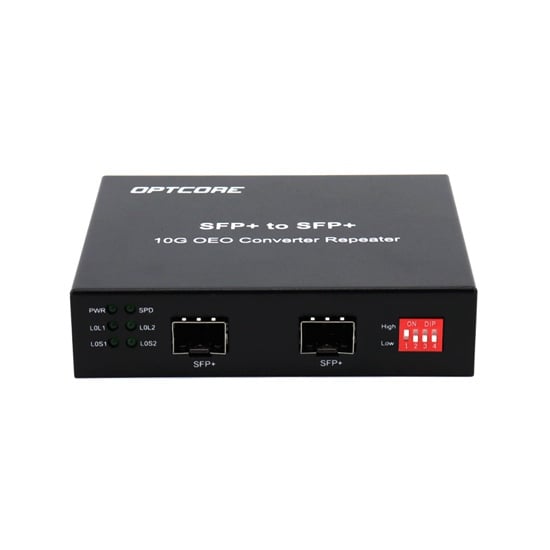Blog, Networking Device
How to Convert Multimode to Single-mode Fiber: A Complete Guide
In modern communication networks, fiber optic cables are everywhere. Whether in the core network, access network, or even connecting the end-user optical cat, fiber is like a chain connecting every device in the network. These cables can be broadly categorized into Multimode (MMF) and Singlemode Fiber (SMF).
However, these two fiber types have different core diameters and are suitable for various application scenarios. But, for the networks with singlemode and multimode fibers, can we connect the MMF and SMF directly? How can we convert the multimode to a singlemode fiber system? This complete guide will provide answers to these questions.
Can we connect the multimode with single mode fiber directly?
In general, single-mode fiber and multimode fiber cannot be directly connected. That is because SMF and MMF have different core diameters and light propagation modes. A direct connection can lead to severe signal loss and unstable communication, with the intuitive result that the transmission distance of an optical link is highly reduced or even mid-link. To understand the difference between multimode and single mode fiber, read our other blog post “Single Mode vs Multimode Fiber, What is The Difference?“
Connecting these two different fibers by direct fiber fusion splicing is also difficult. On the one hand, this is due to the differences in the fiber cores, and on the other hand, the different types of light sources result in entirely different transmission efficiencies of the optical signals over the different fibers.
In practical applications, there are usually three methods for converting multimode to single-mode fiber or vice versa. We will introduce each method one by one next.
Fiber to Fiber Media Converter
Fiber-to-fiber media Converter is the most common device for converting between different optical light signals. It generally features two fiber ports, like SFP port or other transceivers. The two ports allow network administrators to insert different SFP modules to build connections between multimode and single-mode networks quickly.

By converting multimode networks to single-mode networks, users can easily extend the transmission distance from 100km to 180km via SMF. That helps the users extend the life of multimode networks and build long-range point-to-point connections. Therefore, it is suitable for long-distance optical networks across multiple buildings and cities for industrial Ethernet, remote surveillance, and automated factory equipment.
However, besides the single-mode multimode conversion feature mentioned above, the fiber media converter helps convert different wavelengths and optical topologies. An example is converting regular dual fiber networks to single fiber (BiDi networks) or CWDM&DWDM networks. At this point, it regenerates the signal to another type to save the fiber sources, sometimes called 3R (re-amplify, reshape, and retime).
The image below shows a brief diagram of these media converters.
The most popular fiber-to-fiber mode converters include 1G SFP and 10G SFP+ types. Explore our product catalog and find the one that best meets your needs.
WDM Transponder
The WDM transponder is another device that can realize single-mode and multimode conversion. This transponder adopts the optical-electrical-optical (OEO) conversion principle, which can recognize optical signals’ regenerative amplification and wavelength conversion. By inserting a conventional multimode module at one end and a long-haul WDM module at the other, the converter can help users quickly interconnect traditional multimode systems with single-mode fiber systems.

Unlike the fiber-to-fiber media converters mentioned above, WDM transponders are usually equipped with multiple optical ports. They are often used in fiber optic relay and resource-constrained transmission scenarios. Together with CWDM/DWDM multiplexer/demultiplexer, they can realize wavelength division multiplexing transmission, wavelength conversion, OEO signal amplification, service link protection, mirroring, etc. They are especially suitable for SDH/SONET, CPRI, Ethernet, and other optical communication systems.
It should be noted that the price of WDM transponders is generally higher than that of conventional multimode to single mode fiber converters. Therefore, users and network operators must combine their actual needs and budget to choose the right equipment.
Mode Conditioning Patch Cable
Now, let’s look at the third method: the Mode Conditioning Patch Cable (MCP). Unlike the previous two devices, the MCP patch cable is typically a passive device consisting of a single-mode fiber and a multimode fiber offset by the exact location of the fiber’s center. The offset helps to diffuse the single-mode laser light into the center of the multimode fiber core, resulting in the Differential Mode Delay (DMD) effect.

Therefore, MCP patch cords are usually used for single-mode optical modules transmitted over conventional multimode fibers, such as 1000BASE-LX or 10GBASE-LRM. By coupling single-mode light beams to conventional OM1/OM2 MMF systems, signal attenuation can be effectively reduced to increase the transmission distance.
Compared to the two methods mentioned earlier, MCP patch cords do not involve any OEO (optical-electrical-optical) conversion processes. Instead, they rely solely on basic optical signal processing, which results in a lower cost. However, this method is only suitable for converting single-mode optical signals in multimode fiber transmission scenarios, and it cannot convert single-mode optical signals into multimode optical signals. Consequently, the applications for this method are more limited.
Conclusion
Simply put, if you only need MMF to SMF conversion, go ahead with the fiber-to-fiber media converter. If you want to use the single mode transceiver on legacy multimode fiber cabling, MCP cable may be the most cost-effective method. However, a WDM transponder will be the best choice if you have few optical blades but want to extend transmission capacity.
OPTCORE offers a broad line of multimode to single mode fiber conversion products, including the 1G SFP Fiber to Fiber media converter, 10G SFP+ OEO converter, and MCP patch cable, to meet your one-stop needs while with competitive pricing.
Read more
- Single Mode SFP vs Multimode SFP: What the Differences Are & When to Use Each
- Single Mode vs Multimode Fiber, What is The Difference?







